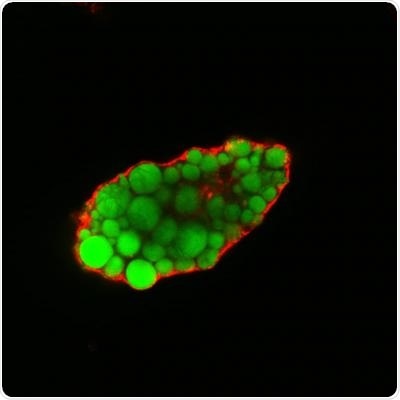Several foods such as mozzarella on a pizza, the olive oil in salad dressing, or hollandaise sauce used on asparagus contain lots of fat.
These foods contain fatty acids that are vital nutrients for people to survive.

Lipid droplets (colored) in a fat cell that lacks EHD2. Image Credit: Claudia Matthaeus, MDC.
The body immediately converts excess fatty acids into energy when someone consumes more fatty acids. The additional amount is then stored in tissues, usually in the form of undesirable rolls of fat around the hips or stomach, which serves as a form of reserve supply.
An extensive array of factors govern the number of fatty acids transported by the blood to the tissues and stored there.
One of these factors was currently identified as the protein EHD2 by scientists at the Max Delbrueck Center for Molecular Medicine in the Helmholtz Association (MDC).
A complete lack of this protein could lead to considerably more intake of fatty acids by fat-storing cells from the cellular environment. This phenomenon was first noticed by Dr. Claudia Matthaeus in the brown adipose tissue of mice during her studies at the MDC.
A specifically interesting fact is that the EHD2 has a seemingly crucial role in human fat metabolism also.
We have discovered that overweight people produce less EHD2 than people with normal weight.”
Dr Claudia Matthaeus, Researcher, Max Delbrueck Center for Molecular Medicine in the Helmholtz Association
It is still not clear why this is so. With the new understanding, Matthaeus and her team, which includes scientists from the MDC research group headed by Professor Oliver Daumke, predict that EHD2 regulates a metabolic pathway that controls the uptake of fatty acids in fat cells.
In the PNAS journal, the researchers report that this pathway is modified in obesity.
Cellular uptake of fat occurs when portions of the cell membrane pinch off
Oliver Daumke, a structural biologist, has known EHD2 for a long time. The structure and mechanism of this protein have been characterized by Oliver for more than a decade.
EHD2 is found inside muscle and fat cells as it is a membrane protein. Small flask-shaped membrane structures named caveolae are formed when the cell envelope folds inward.
These transpositions either tend to stay on the cell membrane surface or pinch off and transport foreign material such as fatty acids into the cell. Named endocytosis, this process was explained by Daumke.
Daumke has predicted that the EHD2 protein assembles into ring-like structures, surrounding the neck of the membrane vessel, and hinders the pinch-off process. He is confident that the absence of EHD2 as a stabilizer leads to more frequent pinch-off of the caveolae, eventually resulting in increased uptake of fat.
This is what Matthaeus and her team investigated. The scientists performed tests on mice in which the EHD2 gene had been turned off.
Matthaeus noticed using an electron microscope that in contrast to normal mice, more and more caveolae had been detached from the plasma membrane.
Thus, she could identify that the uptake of fatty acids was higher in cells that lack EHD2 and that the lipid droplets, or intracellular accumulations of fat, were larger in such cells.
Obesity influences EHD2 production
Matthaeus wondered whether it would be possible to observe the impact of EHD2 on fat metabolism in humans. Therefore, she collaborated with a colleague from Leipzig University to investigate tissue samples from men and women with varying weights.
Soon, she found that the production of EHD2 by cells was less in overweight people (body mass index of 25 or higher) compared to slim people. She predicts that there is a correlation between the formation of fat depots and frequent membrane pinch-off.
During obesity, we observed that the number of caveolae and their detachment from the membrane get out of sync.”
Dr Claudia Matthaeus, Researcher, Max Delbrueck Center for Molecular Medicine in the Helmholtz Association
In November 2019, Matthaeus left the MDC to join the National Institutes of Health in the United States. There she intends to continue her studies into fat metabolism and caveolae.
There are still many unanswered questions.”
Dr Claudia Matthaeus, Researcher, Max Delbrueck Center for Molecular Medicine in the Helmholtz Association
At present, her focus is specifically on analyzing the transport of fatty acids within the cell and the formation of lipid droplets.
Source:
Journal reference:
Matthaeus, C., et al. (2020) EHD2-mediated restriction of caveolar dynamics regulates cellular fatty acid uptake. Proceedings of the National Academy of Sciences of the United States of America. doi.org/10.1073/pnas.1918415117.